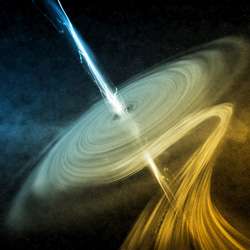Credit: Thinkstock
Scientists have been studying light from distant objects in the night sky for thousands of years in an effort to understand the Universe. Now European researchers have developed a novel method for estimating the mass of often-obscured black holes that could provide insight into the evolution of galaxies.
One of the most common tools used to study the cosmos today is spectroscopy, essentially the study of light. Light exists in a continuum of frequencies and associated wavelengths (the electromagnetic (EM) spectrum), only a small portion of which is visible to the naked eye.
All objects produce complex patterns of lines associated with emission and absorption of certain wavelengths (spectra), enabling identification of their elemental compositions, temperature, density and motion.
The spectra of virtually all atoms, molecules and many other particles lie in the infrared (IR) region of the EM spectrum, making IR spectroscopy the best way to ‘see’ these elements in space.
In addition, because IR can penetrate heavy dust that often surrounds astrophysical objects, IR spectroscopy can yield critical information about objects hidden from optical view.
Since the Universe has been expanding since its creation, spectral lines that would normally appear in other regions of the EM spectrum are shifted into the IR for very distant objects, making IR a great window into conditions of the early Universe.
Most large galaxies have lots of stars, interstellar gas and so-called dark matter. A small percentage of them, active galactic nuclei (AGN), also have supermassive black holes (BHs) at their centres that eject huge amounts of energy in two jets in opposite directions.
EU-funded scientists working on the project ‘The mass and growth of (obscured) black holes and their host galaxies since the Universe was young’ (HIGH-Z BLACK HOLES) employed IR spectral data of gas emission lines from AGN to develop a novel method to quantify AGN properties including BH masses.
HIGH-Z BLACK HOLES scientists discovered an outflow of hydrogen gas likely driven by the jet of an AGN. Such outflows could affect the formation of new stars in their host galaxies. Using spectral information from the huge amount of gas entrained by the jet, they estimated the mass of its associated BH.
The new method for estimating BH mass will facilitate studies of the evolution of obscured BHs and provide information on the Universe when it was young. This is of general interest to a broad scientific audience and the general public, and of particular importance in planning future space observation research.
Provided by CORDIS























